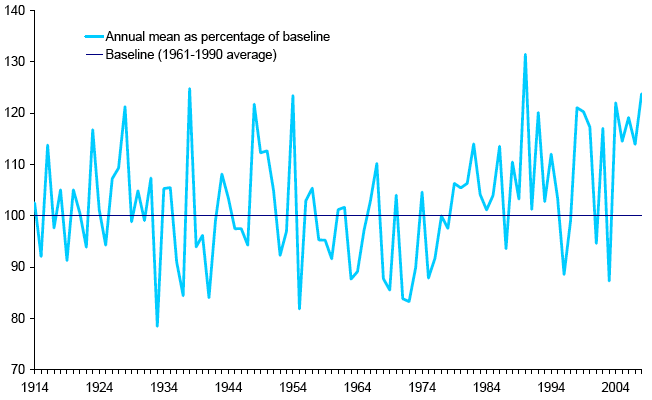Key Scottish Environment Statistics 2009
Annual publication containing summary of key statistics on environmental trends in Scotland
Global Atmosphere
Annual Precipitation R: 1914-2008
Annual precipitation as a percentage of 1961-1990 average 1

1910s 2 |
1920s |
1930s |
1940s |
1950s |
|
|---|---|---|---|---|---|
Average annual precipitation (mm) |
1,396 |
1,458 |
1,384 |
1,410 |
1,406 |
Percentage of 1961-1990 baseline 1 |
100.4 |
104.8 |
99.5 |
101.4 |
101.1 |
1960s |
1970s |
1980s |
1990s |
2000s 2 |
|
Average annual precipitation (mm) |
1,328 |
1,320 |
1,469 |
1,530 |
1,560 |
Percentage of 1961-1990 baseline 1 |
95.5 |
94.9 |
105.6 |
110.0 |
112.2 |
Global warming will have an effect on all weather patterns, and changes in the amount of rainfall are predicted. The UK Climate Projections climate scenarios 5 indicate that rainfall patterns in Scotland will change to wetter winters and drier summers. It is estimated that by 2080, in some areas winters will be around 21% wetter, while summers will be around 16% drier. Precipitation changes have several implications for Scotland, affecting water resources, flood and drought risk and habitat loss.
The average annual precipitation in the 1980s, 1990s and the period between 2000 and 2008 was higher than in previous decades, particularly the 1970s, which contained several years with below average rainfall.
The average winter 6 precipitation in the 1990s and 2000s was about 24% higher than the 1961-1990 baseline, compared to the 1960s which was about 10% lower. Summer 7 precipitation has not differed as much, with the average 1990s figure about 4% less than the baseline and the 2000s figure 11% more.
Source: Met Office
There is a problem
Thanks for your feedback